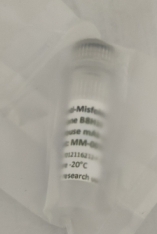 首页>
生物试剂
首页>
生物试剂
商家描述
产品评价(0)
Target
DscamL
Target background
Down syndrome cell adhesion molecule-like protein 1 (DscamL) is a cell adhesion molecule that plays a role in neuronal self-avoidance. It promotes repulsion between specific neuronal processes of either the same cell or the same subtype of cells. DscamL mediates both isoneuronal self-avoidance for creating an orderly neurite arborization in retinal rod bipolar cells and heteroneuronal self-avoidance to maintain mosaic spacing between aII amacrine cells. DscamL has been detected in heart, liver, pancreas, skeletal muscle, kidney and brain.
Specificity
A specific antibody against DscamL. The antibody recognizes the C-terminal of the chicken DscamL protein (aa 761 to 1072).
Clone ID
DS1-96
Isotype
IgG1 kappa
Preservative
None
Format
Purified with protein G, stored in PBS pH 7.4 and lyophilized.
Recommend starting dilution
If reconstituted with deionized water in 200 µL: IHC 1:10 - 1:100. Optimal dilution has to be determined by the user.
Limitations
Research Use Only
Storage
Lyophilized antibodies can be kept at 4ºC for up to 3 months and should be kept at -20ºC for long-term storage (2 years). To avoid freeze-thaw cycles, reconstituted antibodies should be aliquoted before freezing for long-term (1 year) storage (-80ºC) or kept at 4ºC for short-term usage (2 months). For maximum recovery of product, centrifuge the original vial prior to removing the cap. Further dilutions can be made with the assay buffer. After the maximum long-term storage period (2 years lyophilized or 1 year reconstituted) antibodies should be tested in your assay with a standard sample to verify if you have noticed any decrease in their efficacy. To limit antibody loss or degradation, BSA (final concentration 1%) and sodium azide (final concentration 0.02%) can be added to the suggested first dilution. It is important to first verify if those preservatives are compatible with your assay.
 会员登录
会员登录.getTime()%>)
 购物车()
购物车()

 成功收藏产品
成功收藏产品